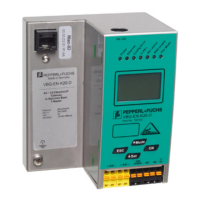AS-Interface
Appendix: the first commissioning with CompactLogix
Subject to reasonable modifications due to technical advances. Copyright Pepperl+Fuchs, Printed in Germany
Pepperl+Fuchs Group · Tel.: Germany (6 21) 7 76-0 · USA (3 30) 4 25 35 55 · Singapore 7 79 90 91 · Internet http://www.pepperl-fuchs.com
Issue date - 24.4.2007
138
6. Select the entry Generic Ethernet Module and confirm with OK.
7. Now register all necessary characteristics of the module:
• Controller name
• Comm. format
• IP-Address
• Connection parameters
• Assembly Instance - Input/Output
• Assembly Instance - Configuration
(Register here a number between 1.. 255)
• Assembly Instance - Size
In this example the Input Instance 114 and the Output Instance 150 is used (92
bytes for in and output data).
Allocation of the data
32 bytes for digital data (A/B slaves)
24 bytes for analog data (slave address 29 .. 31)
36 bytes für command interface
(Register here a Number
$1!)
Assembly Instances
A so-called Assembly Object specifies the structure of objects for the data
communication. The data (e.g.: I/O data) can be combined into blocks with the
Assembly Object Data and sent over only one communication link.
Thus less access to the network are necessary.
It is differentiated between Input Assemblies and Output Assemblies:
-Input Assembly reads application data over the net and/or produces data on
the network.
-Output Assembly writes data on the application and/or prozesses data of the
network.

